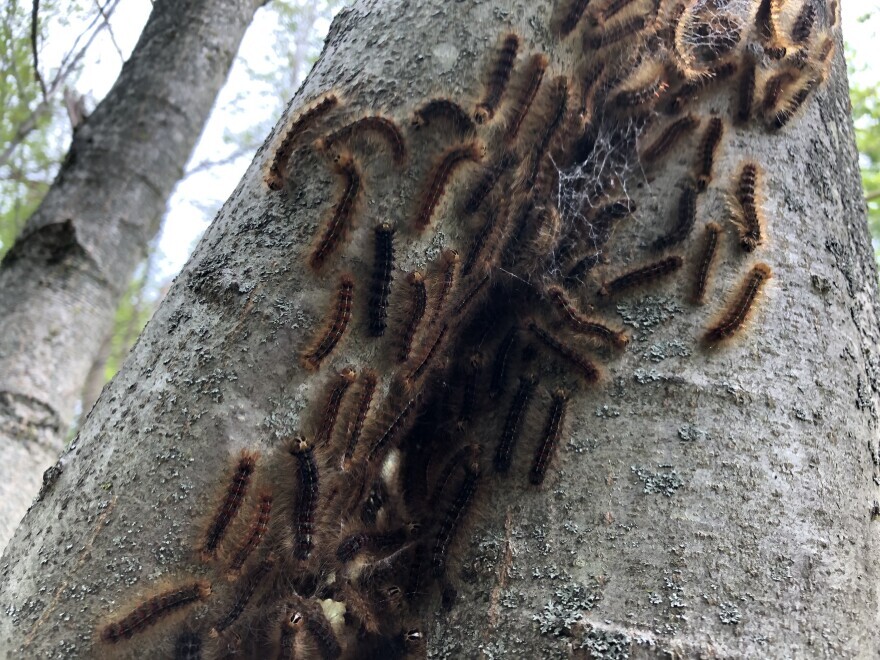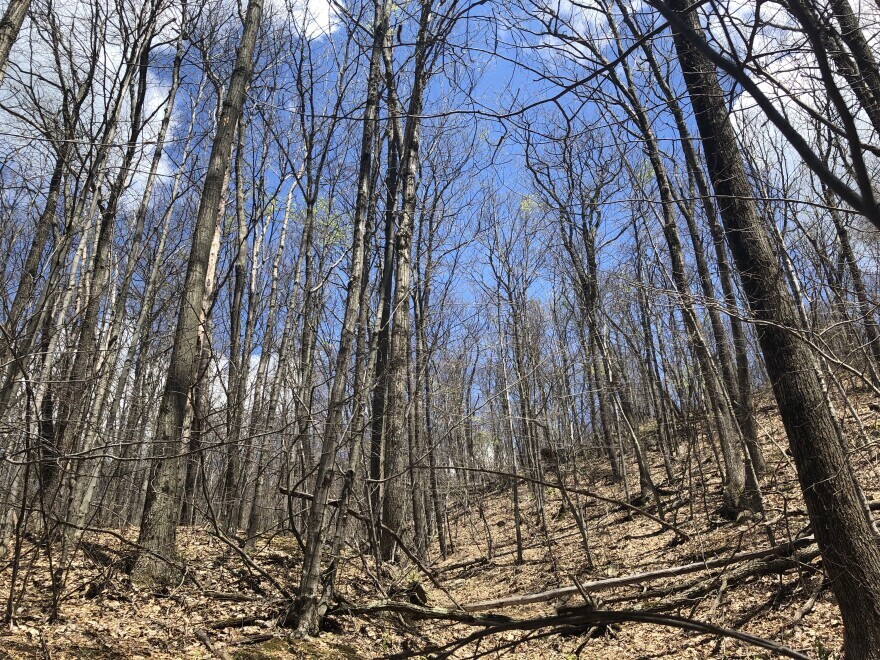A common forest pest had a slur in its name. Now it’s getting a makeover

Female spongy moths lay spongy egg masses that overwinter and hatch as tiny tree-defoliating caterpillars in the springtime. (Jane Lindholm/VPR)
If you live in a place where a moth known by the scientific name Lymantria dispar did damage last summer, you probably can’t forget it.
In the first significant outbreak in many years, the caterpillars munched their way through wide swaths of forest in Vermont and other northeastern states in 2021. Entire hillsides were stripped of foliage, looking like some post-apocalyptic summer stick season. Vermont officials documented more than 50,000 acres of defoliation using aerial surveillance.
Jessica Ware, president of the Entomological Society of America, describes it this way: “They basically, like the Very Hungry Caterpillar, are just chewing their way through deciduous forests. It’s actually a very huge economic devastation that we’re talking about for Lymantria dispar.”
More from VPR: ‘Absolute Nightmare Scenario’: Caterpillar Outbreak Defoliating Northeast Trees
Ware says the moth does hundreds of millions of dollars’ worth of damage every year in the eastern United States. But the moth does other damage, too, with its common name. Since it was first released from a lab in Massachusetts in the 1800s, it’s been called the “gypsy moth.”
Magda Matache, a Romani scholar and director of the Roma Program at Harvard University, says the moth’s name had dehumanizing effects on Romani people.
“It equated our people to insects,” she says. “Way too often, Romani people have been dehumanized through the means of language and associated with insects, animals, criminality, opulence, violence and so on.”
Beyond that: “Gypsy is considered a racial slur by many Romani people,” Matache said. “It carries a very painful history, and it is offensive.”
Ware agrees: “There was no need, really, in 2020, 2021, 2022 to have racial slurs in insect names.”
So last year, the Entomological Society started an initiative called the Better Names Project to address this and other insects in need of rebranding.

Spongy moth caterpillars convene on a tree trunk in the summer of 2021 in Monkton, Vermont. (Jane Lindholm/VPR)
Matache was part of the entomological society’s working group charged with finding a new name. But she says many of the initial new suggestions were nearly as bad.
“For instance, some proposed replace gypsy moth with wandering moth, traveler moth, tent moth, Egyptian moth, gyp moth and so on,” she said. “It felt like they were insisting to keep these insects somehow related to Romani people!”
After getting nearly 200 suggestions, consulting with more than 1,000 people and putting the final choice out for public comment, the group came up with a new name. The Entomological Society voted to accept it and officially announced the new name on March 2.
From now on the common name of Lymantria dispar is: spongy moth.
Ware says the new name is closely tied to the moth’s characteristics: the egg masses of these moths are kind of spongy-looking as they overwinter on trees.
Plus, she says, that name is basically how the moth is referred to in other languages. Like in France and French-speaking Canada, it’s called la spongieuse, meaning “the sponginess.” And in Turkey and Germany, the name translates to sponge-knitter moth and sponge-spinner moth, respectively.
Here in Vermont, state entomologist Judy Rosovsky, thinks changing offensive insect names is a great idea.
“This is a perfect example of how we can all pitch in pretty easily and make a positive change,” she says. However, even with the scientific community on board, it can be hard for both them and the general public to get used to a new name.
“Remember when [paleontologists] changed the name of brontosaurus to apatosaurus?” she asks, by way of example. Even years later, the new name hasn’t totally caught on.
“If you say brontosaurus, everybody knows what you’re talking about,” Rosovsky said. “So I feel like it’s going to be a slow transition.”
We’re likely to have plenty of chances to get used to saying “spongy moth” this spring and summer. We may well be in for another significant outbreak if an environmental predator doesn’t emerge.
Entomophaga maimaiga is an introduced fungus that can kill the spongy moth caterpillar. But this fungus needs wet conditions to thrive, and last year’s widespread drought meant the caterpillars could devour the forest relatively unchecked.
Sometimes, in the past, the state has done aerial spraying with an insecticide called Btk that can also kill spongy moth caterpillars. But Rosovsky says there isn’t really the desire or the funding to do that kind of widespread spraying this year.
“So we’re advising people, if they’re concerned and they have a certain amount of property, or they have trees they’re very concerned about, then they might want to try to find an arborist or tree care company who could come and treat their trees,” she said.
Landowners have until March 15 to apply for an aerial treatment permit, which Rosovsky acknowledges is before they’ll know how bad the outbreak is going to be.

In June of 2021, this Monkton, Vermont hillside was completely defoliated by spongy moth caterpillars. (Jane Lindholm/VPR)
On the statewide level, there’s a larger concern. Gillian Galford, a climatologist at the University of Vermont, says it’s not so much one or even two years of spongy moth defoliation that’s the worry.
“These trees will survive one year of this sort of episode,” she says. “They have enough stores in the soils, in their roots, to get through it. But combined with multiple stresses, like another year that is like that, an extreme drought, or other stressors for several years, this could actually lead to long-term damages to our forests.”
As Vermont’s climate changes, something that healthy forests could survive — like a couple of years of spongy moth outbreaks — could become a deeper worry.
Have questions, comments or tips? Send VPR a message or tweet @vprnet.
